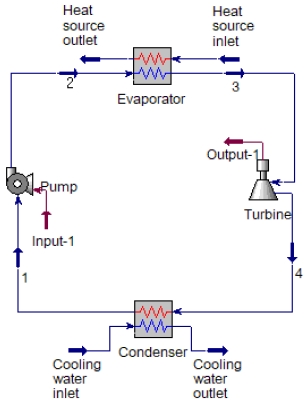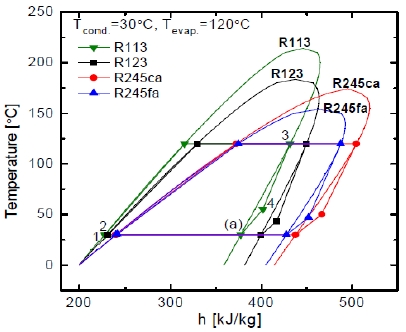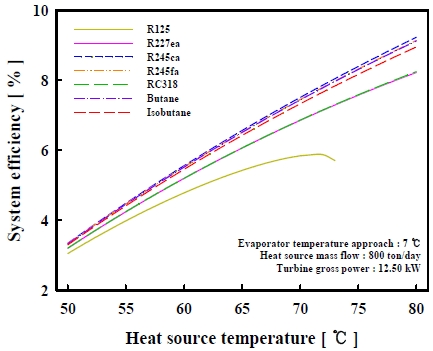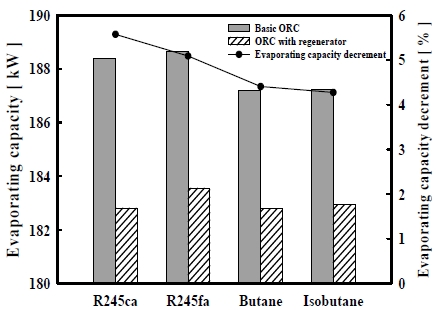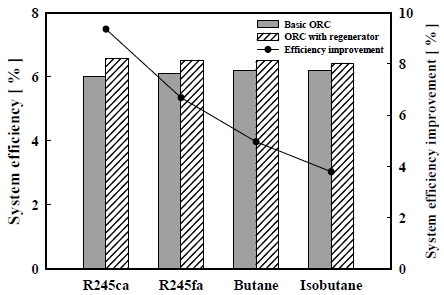
Evaluation of the applicability of a binary cycle for the utilization of hot spring water
Copyright © The Korean Society of Marine Engineering
This is an Open Access article distributed under the terms of the Creative Commons Attribution Non-Commercial License (http://creativecommons.org/licenses/by-nc/3.0), which permits unrestricted non-commercial use, distribution, and reproduction in any medium, provided the original work is properly cited.
Abstract
The applicability of hot spring water to binary cycles or organic Rankine cycles (ORCs) was empirically verified in Japan and Indonesia where hot spring water is used as a heat source for power generation. The purpose of this study was to introduce an ORC/binary system and verify its applicability by using hot spring water-approximately 65 ℃ from the Dongnae area of Busan. The system efficiency and generated power were estimated by a simulation analysis prior to the introduction of the system, and the analysis was conducted to select an optimum working fluid and derive an efficiency improvement method. The analysis results showed that the system efficiency of the basic cycle was highest at 6.20%, when butane was used as a refrigerant, followed by isobutane, R245fa, and R245ca. As a result of analyzing the cycle performance by applying regenerators to only the top four refrigerants, an increase in efficiency of 9.36% compared with the efficiency of the basic cycle was confirmed when R245ca was applied. Regarding the cycle performance change due to the degree of super-heating at the turbine inlet, system efficiency tended to increase as the super-heating degree increased for all four refrigerants. When a super-heating degree of 6 ℃ was set, the efficiency of the system with R245ca was the highest at 6.93%. This indicated that butane is the optimum refrigerant for application in the basic binary cycle, and that it is reasonable to select R245ca as the working fluid for a binary cycle with a regenerator.
Keywords:
Binary cycle, hot spring water, Organic Rankine cycle, Regenerator1. Introduction
Countries worldwide are beginning to pay attention to renewable and unused energy sources to address problems such as global environmental issues and imbalances in energy demand and supply. Renewable energy sources, including solar heat, solar photovoltaic, biomass, wind, small hydropower, geothermal energy, and marine energy, have infinite potential and are being highlighted as a solution to energy problems. In the case of hot spring water, a type of geothermal energy, many countries such as Indonesia and Japan are seeking methods to produce power using hot spring water as an unused energy source.
C. Y. Park et al. [1] proposed the organic Rankine cycle (ORC) as a power generation system to produce power at low heat source temperatures and described the cases and characteristics of countries worldwide for using ORCs for biomass, solar heat, geothermal energy, and waste heat utilization. They predicted that the utilization of ORCs would expand because ORC power generation systems use low-temperature heat sources and are therefore highly applicable despite low efficiency.
Y. J. Baek et al. [2] described the characteristics, benefits, and shortcomings of the dry steam, flash steam, and binary methods for using geothermal energy.
Among them, the binary cycle that applied the Kalina cycle reduced irreversibility in the heat exchange process using the phase change process of the fluid. It was applied to ocean thermal energy conversion (OTEC) and geothermal power generation. They used the 75 kW OTEC power generation system from Saga University in Kyushu, which used R22 and ammonia, as an example.
H. C. Cho [3] also described the size of geothermal resources in each country and the ORC and Kalina power generation methods to use such resources. As the applicability of ORC systems has been verified worldwide, many global companies, including Ormat, are commercializing ORC systems. In South Korea, a 1 MW class ORC system was installed at Pohang Iron & Steel in 1999, and an ORC system of 250–300 kW, which uses industrial waste heat, geothermal energy, and ship waste energy as heat sources, is being developed.
Indonesia and Japan have already introduced binary cycles or ORCs that use hot spring water and have used them for power production. The related previous studies are described below.
Table 1 presents the heat source temperature, acidity, and flow rate of hot spring water distributed in Indonesia. N. Rohmah et al. [4] analyzed the power generation cycle using hot spring water with a temperature range of 37.1–96.4 ℃ and used R227ea as the working fluid. They analyzed the thermal and energy efficiencies, total energy loss, and generated power. They confirmed that the generated power was 168.3 kW when they supplied 3,000 LPM of hot spring water at 93.5 ℃ 9 kW for 180 LPM at 87 ℃ and 2.4 kW for 60 LPM at 76.5 ℃.
As seen, many studies have already been conducted on the ORC power generation system that produces power using new and renewable energy sources [5]-[7], and studies that use hot spring water as an unused heat source have been conducted as well. Moreover, many studies have also been conducted on the selection of an optimum working fluid for ORCs and on the improvement of the efficiency of the regenerator and feed liquid heater.
The purpose of this study was to verify the applicability of an ORC using hot spring water at 65 ℃ from the Dongnae area of Busan. Seven working fluids were selected, including additional refrigerants to the ones cited in previous studies. A cycle performance analysis was conducted, and the efficiency improvement rate was analyzed when the regenerator was applied. The results of this study will be used as basic research data for the introduction possibility and utilization of an ORC power generation system that uses hot spring water.
2. ORC with a Regenerator
2.1 Basic ORC
Figure 1 shows the schematic diagram of the basic ORC, which consists of a condenser, an evaporator, a pump, and a turbine. The ORC system uses a fluid with a low boiling point as the working fluid and thus can reduce irreversibility in the heat exchange process using the phase change of the fluid. Regarding the operating principle, the refrigerant is condensed at a condenser by exchanging heat with a low-temperature heat source, and the condensed refrigerant liquid is transported to evaporator by a pump. The transported refrigerant liquid is vaporized at the evaporator by exchanging heat with a high-temperature heat source. The saturated gas or super-heated gas is discharged from the evaporator outlet; it is then input to the turbine. It drives the turbine and expansion is performed from a high pressure to low pressure. In this case, the inflation process in the turbine is an isentropic process from an ideal perspective, and the inflation efficiency of the turbine is an important parameter in the ORC. The refrigerant gas that passed through the turbine is input to the condenser and condensed, thereby, completing a cycle.
2.2 ORC with a regenerator
Figure 2 shows the schematic diagram of an ORC with a regenerator. A regenerator was added to the configuration of the basic ORC. The application of the regenerator has a benefit of reducing the heat required by an evaporator because the residual enthalpy after the turbine expansion process is recovered by the super-cooled fluid at the pump outlet through heat exchange between the fluids at the turbine and pump outlets. A reduction in the required heat, which affects the system efficiency improvement, varies depending on the heat recovered by the regenerator, and the heat exchange capacity of the regenerator is different depending on the physical properties of the working fluid. In a related previous study, C. Y. Park et al. [8] confirmed the cycle efficiency improvement by applying a regenerator and feed liquid heater to the basic ORC and found that the efficiency improvement was at the highest when R245ca was applied to the ORC with a regenerator. With R245ca, the enthalpy at the turbine outlet was higher than for other fluids in the T-h diagram, as shown in Figure 3. This means that the amount of heat that can be recovered by the regenerator is large. In this study, seven refrigerants, including R245ca, were selected and analyzed.
2.3 Previous geothermal power generation systems
Among the cycles used in previous geothermal power generation systems, studies have been conducted on the Kalina, Uehara, and double Rankine cycles. The Kalina cycle drives the turbine using water and ammonia as the working fluids. The Kalina cycle is characterized by ammonia in the vapor state and water in the liquid state for preheating the low-temperature fluid before it enters the evaporator. The application of the regenerator enables heat recovery at the evaporator, and a cycle is completed as the ammonia vapor is absorbed by water and condensed in the condenser. The Kalina cycle is applied based on a high-temperature heat source from 120-200 ℃ in many cases. The system efficiency with a heat source at approximately 65 ℃ applied to this study was 4.791%, which was approximately 25% lower compared with the basic ORC, and therefore, it was excluded from the cycle analysis. As with the Kalina cycle, the Uehara cycle requires a high-temperature heat source at 120 ℃ or higher. Its flow rate balance is not stable due to the complicated configuration and multiple branch points; therefore, it is difficult to find actual cases where it was applied. The double Rankine cycle is a method for improving the heat exchange efficiency from the heat source and heat sink using two ORCs. It can effectively utilize the temperature difference between the heat source and heat sink by reducing irreversibility in the heat exchanger. However, multiple component devices are required, and the benefit earned from the system efficiency improvement is expected to be larger when the system is applied to a high-temperature heat source considering the volume and initial cost of the system.
3. Analysis Conditions and Methods
3.1 Working fluid selection
Seven working fluids were selected for the analysis in this study. These fluids were selected because the condensing pressure, which corresponds to the low pressure of the cycle, was equal to or higher than atmospheric pressure and the cycle could be a subcritical cycle for which the critical temperature did not exceed the heat source temperature of 65 ℃. Moreover, refrigerants with an ODP of zero, the fluids that exhibited high cycle performance, or the selected fluids in previous ORC studies, R125, R227ea, R245ca, R245fa, RC318, Butane, and Isobutane were selected. Among them, R245fa is a toxic refrigerant classified as B1 in the safety group, but it was selected because it exhibited high performance in ORCs. Butane and isobutene are explosive hydrocarbon-based refrigerants corresponding to A3, but they are also classified as refrigerants with high performance and were frequently mentioned in previous ORC studies. RC318 has a normal boiling point of - 6 ℃ and it is a PFC-based refrigerant corresponding to A1, but its GWP is 10,300 and it is one of the refrigerants under regulation by the Montreal Protocol from 2020. In this study, the analysis was conducted with the above-mentioned refrigerants to compare the cycle performance of each working fluid.
3.2 Operating condition settings
Table 2 shows the cycle operating conditions required for the analysis. The heat source temperature was based on 65 ℃ hot spring water from the Dongnae area of Busan. The temperature of the heat source was set as a parameter to examine changes in the cycle performance when the temperature of the hot spring water changed within a range of ± 15 ℃. The flow rate of the hot spring water was assumed to be constant at 800 ton/day. The evaporator temperature approach was based on 7 ℃ and the evaporating temperature was 58 ℃ with a heat source temperature of 65 ℃. The evaporating temperature was fixed for the analysis of the cycle performance using the super-heating degree as a parameter, but the super-heating degree was changed from 0 to 6 ℃ which means evaporator outlet temperature had until 64 ℃. The logarithmic mean temperature difference of the regenerator was fixed at 3 ℃, and the outlet temperature of the 25 ℃ initial water fed into the condenser was fixed at 30 ℃.
The condensation temperature, at which condensation occurs in a condenser, was set to 30 ℃, which was different from the water inlet temperature of 25 ℃ by 5 ℃. The turbine power generation was also fixed at 12.50 kW. Changes in the system efficiency were examined through changes in the heat required by the evaporator for each parameter. The turbine and pump efficiencies were set to 85%. The pressure drop in the heat exchanger was ignored in the analysis because it varied depending on refrigerant and heat exchanger design.
3.3 Data analysis
Through the data acquired from the simulation analysis, evaporation heat, required pump power, and turbine power generation could be identified for the basic ORC and ORC with a regenerator. In addition, the system efficiency was analyzed through the following equation. Equation (1) represents the net power obtained by subtracting the required pump power from the turbine power generation. In Equation (2), the system efficiency was obtained by dividing the net power by the evaporating capacity.
| (1) |
| (2) |
where Wt is the turbine power generation (kW), Wp is the required pump power (kW), Qe is the evaporating capacity (kW), and ηs is the system efficiency (%).
4. Performance Evaluation and Discussion
4.1 Changes in basic ORC performance due to changes in heat source temperature
Figure 4 shows the system efficiency for each refrigerant when the heat source temperature changed in a range of ± 15 ℃ from 65 ℃. When turbine power generation was fixed to 12.50 kW, the system efficiency changed with regard to both decrement of input heat capacity and increment of pump consumption power as the heat source temperature increased. When the heat source temperature increased from 50 ℃ to 80 ℃, the system efficiency tended to increase. In the case of R125, however, an inflection point occurred at a heat source temperature of 71 ℃. This indicated that an inflection point occurred at an evaporating temperature of 64 ℃ considering the evaporator temperature approach. The critical temperature of R125 is 66.18 ℃. When the temperature was close to the critical temperature, the system efficiency dropped sharply because the increment in the required pump power rapidly increased but the decrement in the evaporating capacity decreased relatively linearly. R245ca exhibited the highest system efficiency over the entire range, followed by R245fa, butane, and isobutane. R245fa and butane showed almost similar system efficiency values with an insignificant difference.
In the case of R245ca, the system efficiency increased as the heat source temperature increased, indicating that heat sources with higher temperatures were more suitable for the ORC system. On the other hand, RC318 and R227ea exhibited very similar values in the 50-80 ℃ temperature range, and they were excluded from the performance analysis of the cycle with a regenerator because their system efficiency values were low compared with the top four refrigerants.
4.2 Analysis of ORC performance with a regenerator
Figure 5 compares the evaporating capacity of the ORC with a regenerator to that of the basic ORC system. As an application of a regenerator aims to improve the system efficiency by reducing the evaporating capacity, changes in the evaporator capacity are important for judging the applicability of a regenerator. When R245ca was applied, the evaporation heat decreased by approximately 5.57% in the ORC with a regenerator compared with the basic ORC. For R245fa, butane, and isobutene, the decrease rates were 5.09%, 4.41%, and 4.27%, respectively.
Figure 6 shows the system efficiency improvement in the ORC with a regenerator compared with the basic ORC for R245ca, R245fa, butane, and isobutene, which belonged to the top group in Section 4.1. When R245ca was applied at a heat source temperature of 65 ℃, the system efficiency was 6.764%, which was the highest improvement (9.36%) compared with the basic ORC system efficiency of 6.564%. R245fa, butane, and isobutene exhibited efficiency improvements of 6.684%, 4.964%, and 3.794%, respectively. The system efficiency was also the highest when R245ca was applied. This confirmed that R245ca was also the most suitable working fluid for the ORC system with a regenerator.
Figure 7 shows the regenerator capacity due to an increase in super-heating temperature. Because the evaporating capacity decreased as the regenerator capacity increased, the system efficiency increased as the super-heating degree increased. On the other hand, in the case of isobutane in Figure 7, the regenerator capacity rapidly increased as the super-heating degree increased. This indicates that a higher super-heating degree is more favorable to the heat recovery in the regenerator under the application of isobutane because the enthalpy at the turbine outlet is higher.
Figure 8 shows the system efficiency values of the four working fluids according to the turbine inlet super-heating degree. When the evaporating temperature was 58 ℃ at a heat source temperature of 65 ℃, the overall system efficiency increased as the super-heating degree increased from 0-6 ℃. In the case of R245ca, the system efficiency was 6.764% when there was no turbine inlet super-heating degree, i.e., when a turbine was driven by the saturated gas state at 58 ℃, which was the evaporating temperature. When a super-heating degree of 6 ℃ was given, the system efficiency increased from 2.35% to 6.924%. For R245fa, butane, and isobutane, the system efficiency also improved by 2.56-3.14%. This is because the enthalpy of the turbine outlet increased as the turbine inlet super-heating degree increased. Although an improvement in the system efficiency due to changes in the super-heating degree was low, it is possible to improve the system efficiency with changes in the operating condition alone without adding component devices to the system.
5. Conclusion
In this study, the applicability of the organic Rankine cycle (ORC) power generation system was analyzed using 800 ton/day of 65 ℃ hot spring water from the Dongnae region of Busan. The cycle performance was analyzed by simulating the temperature of the hot spring water, a heat source, and the turbine inlet super-heating degree under the application of a regenerator as parameters. The conclusions of the analysis are as follows.
- (1) Through the application of a regenerator to the basic ORC, the evaporating capacity could be reduced by up to 5.57% when R245ca was applied.
- (2) When the temperature of the hot spring water, a heat source, changed from 50–80 ℃, the system efficiency of R245ca was the highest among the selected seven working fluids, followed by R245fa, butane, and isobutane.
- (3) In the ORC with a regenerator, the system efficiency increased as the turbine inlet super-heating degree increased. This is due to the increase in heat recovery of the regenerator.
- (4) The efficiency of the ORC system with a regenerator exhibited the highest improvement of 9.36% when R245ca was applied as the working fluid, indicating that R245ca is suitable as the optimum working fluid of the ORC system with a regenerator.
Acknowledgments
This work was supported by a Research Grant of Pukyong National University(2017 year).
References
- C. Y. Park, “ORC electricity generation system using low temperature heat source”, Korea Journal of Geothermal Energy, 7(4), p56-63, (2011), (in Korean).
- Y. J. Baek, and G. C. Jang, “Geothermal and low temperature difference electricity generation method”, Korea Journal of Geothermal Energy, 4(3), p32-38, (2008), (in Korean).
- H. C. Cho, “Binary geothermal electricity generation method and design”, Korea Journal of Geothermal Energy, 8(4), p50-55, (2012), (in Korean).
-
N. Rohmah, G. Pikra, R. I. Praman, and A. J. Purwanto, “Energy and exergy assessment of organic rankine cycle electricity generation with hot spring as the heat source in Aceh, Indonesia”, 2016 International Conference on Sustainable Energy Engineering and Application (ICSEEA), p81-87, (2016).
[https://doi.org/10.1109/icseea.2016.7873572]

-
J. I. Yoon, C. H. Son, H. U. Kim, S. J. Ha, H. S. Lee, and H. J. Kim, “Performance characteristics of OTEC(Ocean thermal energy conversion) power cycle with vapor-liquid ejector”, Journal of the Korean Society for Power System Engineering, 18(5), p88-93, (2014), (in Korean).
[https://doi.org/10.9726/kspse.2014.18.5.088]

-
J. I. Yoon, B. H. Ye, J. H. Heo, H. J. Kim, H. S. Lee, and C. H. Son, “Performance analysis of 20 kW OTEC power cycle using various working fluids”, Journal of the Korean Society of Marine Engineering, 37(8), p836-842, (2013), (in Korean).
[https://doi.org/10.5916/jkosme.2013.37.8.836]

-
J. I. Yoon, S. H. Seol, C. H. Son, S. H. Jung, Y. B. Kim, H. S. Lee, H. J. Kim, and J. H. Moon, “Analysis of the high-efficiency EP-OTEC cycle using R152a”, Renewable Energy, 105, p366-373, (2017).
[https://doi.org/10.1016/j.renene.2016.12.019]

-
C. Y. Park, W. K. Hong, and J. M. Kim, “Thermodynamic efficiencies of organic rankine cycles with a feed liquid heater or regenerator”, International Journal of Air-Conditioning and Refrigeration, 23(10), p662-669, (2011), (in Korean).
[https://doi.org/10.6110/kjacr.2011.23.10.662]



